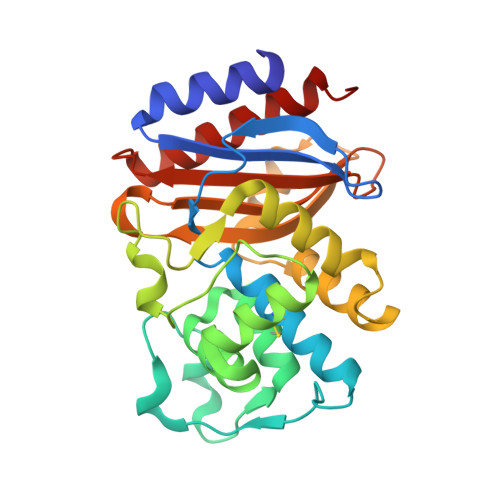Inhibition of class A beta-lactamases by carbapenems: crystallographic observation of two conformations of meropenem in SHV-1.
Nukaga, M., Bethel, C.R., Thomson, J.M., Hujer, A.M., Distler, A., Anderson, V.E., Knox, J.R., Bonomo, R.A.(2008) J Am Chem Soc 130: 12656-12662
- PubMed: 18761444
- DOI: https://doi.org/10.1021/ja7111146
- Primary Citation of Related Structures:
2ZD8 - PubMed Abstract:
Carbapenem antibiotics are often the "last resort" in the treatment of infections caused by bacteria resistant to penicillins and cephalosporins. To understand why meropenem is resistant to hydrolysis by the SHV-1 class A beta-lactamase, the atomic structure of meropenem inactivated SHV-1 was solved to 1.05 A resolution. Two conformations of the Ser70 acylated intermediate are observed in the SHV-1-meropenem complex; the meropenem carbonyl oxygen atom of the acyl-enzyme is in the oxyanion hole in one conformation, while in the other conformation it is not. Although the structures of the SHV-1 apoenzyme and the SHV-1-meropenem complex are very similar (0.29 A rmsd for Calpha atoms), the orientation of the conserved Ser130 is different. Notably, the Ser130-OH group of the SHV-1-meropenem complex is directed toward Lys234Nz, while the Ser130-OH of the apo enzyme is oriented toward the Lys73 amino group. This altered position may affect proton transfer via Ser130 and the rate of hydrolysis. A most intriguing finding is the crystallographic detection of protonation of the Glu166 known to be involved in the deacylation mechanism. The critical deacylation water molecule has an additional hydrogen-bonding interaction with the OH group of meropenem's 6alpha-1 R-hydroxyethyl substituent. This interaction may weaken the nucleophilicity and/or change the direction of the lone pair of electrons of the water molecule and result in poor turnover of meropenem by the SHV-1 beta-lactamase. Using timed mass spectrometry, we further show that meropenem is covalently attached to SHV-1 beta-lactamase for at least 60 min. These observations explain key properties of meropenem's ability to resist hydrolysis by SHV-1 and lead to important insights regarding future carbapenem and beta-lactamase inhibitor design.
- Faculty of Pharmaceutical Sciences, Josai International University, Togane City, Chiba 283-8555, Japan.
Organizational Affiliation:


















